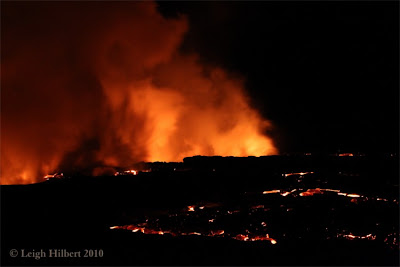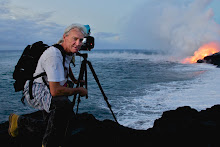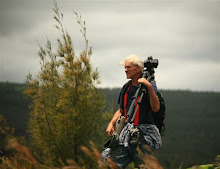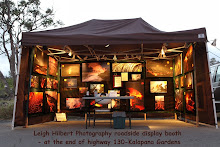 (Click on the images for larger sizes)
(Click on the images for larger sizes)
Shortly after noon yesterday, Pele’s latest surface flow of molten lava poured across the last stretch of land and into the open ocean with great fanfare. This is the first time lava has flowed into the sea here on the Big Island since the Waikupanaha ocean entry ceased on January 3rd this year.
Islander’s have been excitedly watching the progress of the surface flow make its way from the Pu`u O`o eruption site high atop the mountainside and down the Pulama pali, through the County viewing area kipuka (previous lava-spared forest remnants), sever the outer coastal flats viewing area, nearly overtaking the main trailhead viewing area, then down through more kipuka, and finally bursting dramatically out of the forest yesterday at 6:00 AM and reaching the ocean just after 12:00 noon, four hours later.
The public gathered on the trailhead viewing area in the afternoon and evening yesterday to gaze out onto the expansive acreage of still smoldering fields of pahoehoe. There continued to be some openly flowing breakouts of lava, which could be seen day or night. One of these breakouts has concerned County officials because it has moved down directly close and adjacent to the trailhead on the north side. This slow-moving, but still active finger of lava has the potential to spill down onto the terminus of State highway 130, which is presently the County parking location for visitors to the viewing area.
As of 10:00 PM last night there was no definitive word from State, County or Civil Defense personnel, nor the security company managing the area, regarding whether the original Waikupanaha public viewing area & trail will be opened again. There was some speculation that those in charge of these decisions might open it up today. I hope so, it is a spectacular scene to see – starting from the trailhead to the coastal viewing site: hot pahoehoe lava close by to the west of the trail, vegetation still burning here and there a safe distance away, and a wonderful view of still glowing lava entering the sea directly southwest and very close by to the old viewing site.
Lava Viewing Summary
1) The Hawaii County viewing area continues to be a good show and will be all the better if the outer coastal viewing site opens today. Phone Civil Defense at 961-8093 for their recorded update messages, which may not actually offer recent changes but will state whether the area is open or not, or 430-1966 for further information.
2) Halema’uma’u crater vent continues to spew a plume of sulfur dioxide by day and often exhibits a beautiful red glow by night. The Jaggar Museum’s overlook balcony within Hawaii Volcanoes National Park is the best viewing location of the Halema’uma’u crater.



























.jpg)














